TRAVEL: Nine tips for making the most of a Rome city break
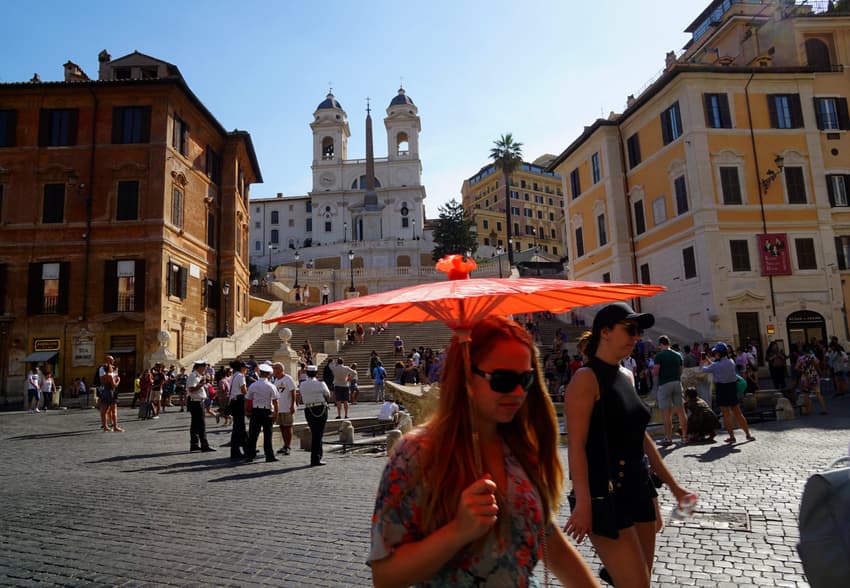
Planning a trip to the Eternal City? Here, The Local's reporter in Rome shares some pointers on making the most of your stay.
Familiarise yourself with the concept of aperitivo
If the aperitivo originated in Milan, it's been wholeheartedly embraced in Rome.
For those unfamiliar with the custom, aperitivo is a kind of Italian happy hour - except instead of discounted or two-for-one cocktails, you get food along with your drink.
This can be anything from a small plate of crisps or bowl of peanuts to bites of sandwiches and pizzette to a full-blown all-you-can-eat buffet (in which case it's more likely to be referred to as an apericena), ideal for travellers looking to fill up on a budget.
Some of the popular Rome bars that used to serve buffets ended the practice for good during the pandemic, but a number of others have now started up again.
Regardless of whether or not you want to substitute an apericena for an actual dinner, sitting down for an aperitivo can be a good way to keep your energy levels up if you're planning on waiting till 9pm to eat like an Italian.
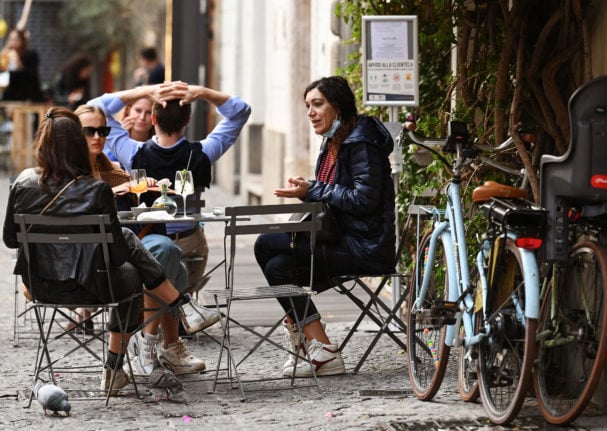
People enjoy an aperitivo in downtown Rome. Photo by Vincenzo PINTO / AFP.
On weekends, book in advance for restaurants
After several years of living in Rome, this one still catches me out: most popular restaurants will be fully booked on Friday and Saturday evenings and for Sunday lunch.
You'll always eventually find somewhere that will take you in - but if you want to avoid being snorted at derisively and turned away from multiple establishments, it's wise to book in advance, especially if you have somewhere well known on your list.

People eat a lunch in a restaurant in Campo dei Fiori square in downtown Rome. Photo by Filippo MONTEFORTE / AFP.
...And museums
Foreign visitors have started returning to Rome en masse, but some Covid restrictions are still in place: meaning that now more than ever, it's important to book visits to the major attractions and museums in advance to avoid being disappointed.
READ ALSO: What you need to know about travel to Italy this spring
This has always been true for the Vatican Museums, where you can expect to queue for hours if you've not booked ahead of time (even if you have booked, you can still expect to wait in line for staff to check tickets and conduct security checks).

A tourist walks outside the Capitoline Museums in central Rome. Photo by ANDREAS SOLARO / AFP.
If you've left it too late to secure a time slot for the most famous attractions, don't assume your trip's a write off - Rome is packed with numerous lesser-known museums and churches that are still worth visiting.
Pick your gelato wisely
There are a lot of great gelaterias in Rome - and a few mediocre ones.
The first time I visited the city, such distinctions were meaningless to me, and I was irritable with an Italian who tried to instruct me otherwise: ice cream is ice cream, and if I want to get one from somewhere right next to the Trevi Fountain, why shouldn't I?
I maintain that food preferences are a matter of inviolable personal taste, and if bright blue bubblegum flavoured gelato is what you like best in the world, then you do you.
READ ALSO: How to spot good quality gelato in Italy – and how to suss out the fakes
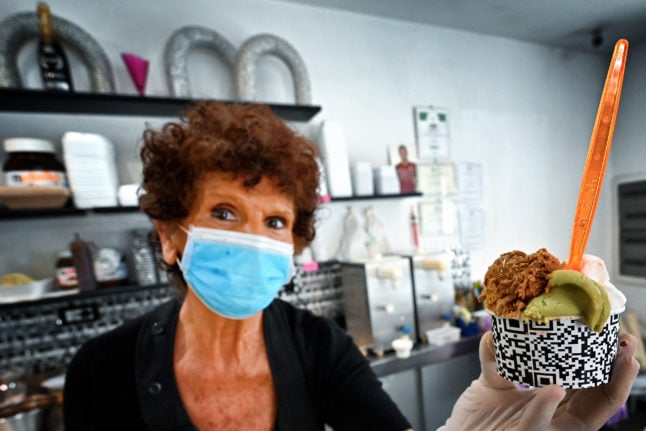 When eating gelato in Rome, it's worth seeking out a quality gelateria. Photo by Alberto PIZZOLI / AFP.
When eating gelato in Rome, it's worth seeking out a quality gelateria. Photo by Alberto PIZZOLI / AFP.
But after consuming many, many gelati, my tastes have regrettably and against my will become more refined than they once were.
If you want a good quality gelato that a Roman would eat, avoid bright artificial colours, places where the ice cream is piled high without melting (it means the gelato is high in vegetable fats and emulsifiers), and shops that are really going out of their way to advertise themselves with a lot of garish signposting.
Do your research on where to eat
In a similar vein, it can be tempting to assume that every restaurant in Rome serves good food just because it's here.
The one time I was persuaded to eat at a place without indulging my neurotic compulsion to first check its ratings on various review platforms, it was bad.
When we looked afterwards, my suspicions were confirmed: it was poorly reviewed online.
READ ALSO: How to spot the Italian restaurants to avoid

People eat at a restaurant by the Pantheon in downtown Rome. Photo by Filippo MONTEFORTE / AFP.
This might not happen to you; but if you're only here for a few days on holiday, why risk not checking that the place where you're about to eat has at least decent reviews?
Restaurants accredited by the Slow Food Association (which was founded in Rome) are a good start: they use only local, seasonal ingredients, so the food tends to be very fresh and flavourful.
READ ALSO: What are the rules on tipping in Italy?
Wear comfortable shoes
Rome is a very manageable city to visit as a tourist, with most of its major cultural and historic sites within walking distance of one another.
That said, the sampietrini cobble stones with which much of the city centre is paved are not kind to wearers of high heels or other stylish but impractical footwear.
If you're planning on strolling around the city for any length of time, make sure to wear - or at least bring with you as a back up - some shoes that won't punish your feet.
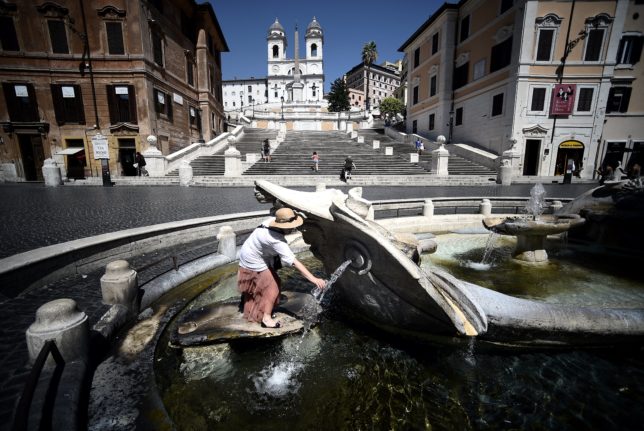
A tourist cools off at the Barcaccia fountain by the Spanish Steps in central Rome. Photo by Filippo MONTEFORTE / AFP
Buy several bus/metro tickets at a time
You can't buy a ticket on the bus in Rome, and the machines that distribute them at metro stations can't necessarily be completely relied upon to work.
The only other place you can buy them is from tabaccherie (tobacconist shops) - but these are often closed in the afternoon and on Sundays.
You'll be stung with a €50 if caught without a validated ticket (time stamped using the small yellow machines you'll see on the buses), so it's important to have one on you. If you're in town for a few days, it's wise to buy several tickets when you get the chance so you won't be caught out.
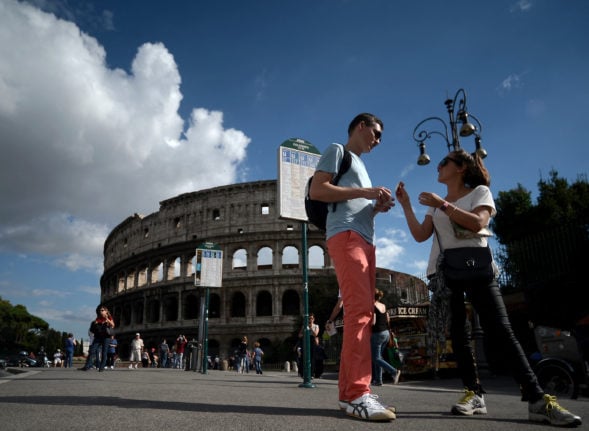
People stand by a bus stop in front of the Colosseum in central Rome. Photo by FILIPPO MONTEFORTE / AFP.
An alternative is the Mycicero app, which allows you to buy and virtually validate Rome bus and metro tickets on your phone.
Budget some time to wander aimlessly
With so much to see and do in Rome, it can be tempting to pack your itinerary till it's bursting at the seams.
But one of the best ways to appreciate the city is by simply meandering around its streets getting lost.
Trastevere, with its shaded alleyways and vine-covered, terracotta-hued arches is an ideal place to soak up some of the city's beauty as a tourist.
Testaccio, just across the river, is a historic Roman neighbourhood where you'll find a thriving food and artisanal products market open every day except Sunday, as well as a 2000-year-old artificial hill made entirely from broken amphorae, once the site of an ancient Roman rubbish dump.

A fruit and vegetable seller picks artichokes at the Testaccio market Rome. Photo by Vincenzo PINTO / AFP.
Don't get too hung up on niceties
You'll often see online reviews that complain about waiters' rudeness in Italian restaurants and bars.
Sometimes, this is fair - there really are places that are particularly rude and dismissive, especially to tourists who don't speak Italian.
But a lot of the time, it's just the way the city is. Being a bit brusque and short with customers is normal - after all, there's a lot of tables to wait and a lot of caffe to serve.
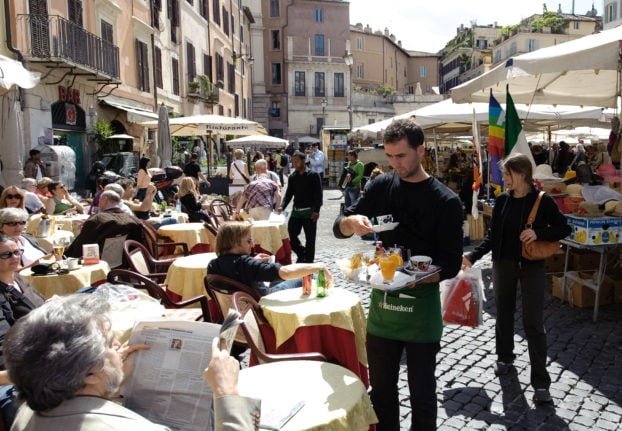
Eating at a bar or restaurant in Rome may be a different experience to what you're used to. Photo by ALBERTO PIZZOLI / AFP.
You'll also find that many less-formal restaurants or trattorie allow people selling roses or sometimes even singers of traditional Roman folk songs to go around customer's tables and ask for change - and diners will often give it to them.
You might find this irritating, but it's good practice to throw your hands up, accept that you're in a foreign country with different customs to your own, and follow the example of locals.
There's some kind of saying about that...
Staying in Rome for longer? Here are 15 simple hacks that make living in the city easier.
Comments
See Also
Familiarise yourself with the concept of aperitivo
If the aperitivo originated in Milan, it's been wholeheartedly embraced in Rome.
For those unfamiliar with the custom, aperitivo is a kind of Italian happy hour - except instead of discounted or two-for-one cocktails, you get food along with your drink.
This can be anything from a small plate of crisps or bowl of peanuts to bites of sandwiches and pizzette to a full-blown all-you-can-eat buffet (in which case it's more likely to be referred to as an apericena), ideal for travellers looking to fill up on a budget.
Some of the popular Rome bars that used to serve buffets ended the practice for good during the pandemic, but a number of others have now started up again.
Regardless of whether or not you want to substitute an apericena for an actual dinner, sitting down for an aperitivo can be a good way to keep your energy levels up if you're planning on waiting till 9pm to eat like an Italian.

On weekends, book in advance for restaurants
After several years of living in Rome, this one still catches me out: most popular restaurants will be fully booked on Friday and Saturday evenings and for Sunday lunch.
You'll always eventually find somewhere that will take you in - but if you want to avoid being snorted at derisively and turned away from multiple establishments, it's wise to book in advance, especially if you have somewhere well known on your list.

...And museums
Foreign visitors have started returning to Rome en masse, but some Covid restrictions are still in place: meaning that now more than ever, it's important to book visits to the major attractions and museums in advance to avoid being disappointed.
READ ALSO: What you need to know about travel to Italy this spring
This has always been true for the Vatican Museums, where you can expect to queue for hours if you've not booked ahead of time (even if you have booked, you can still expect to wait in line for staff to check tickets and conduct security checks).

If you've left it too late to secure a time slot for the most famous attractions, don't assume your trip's a write off - Rome is packed with numerous lesser-known museums and churches that are still worth visiting.
Pick your gelato wisely
There are a lot of great gelaterias in Rome - and a few mediocre ones.
The first time I visited the city, such distinctions were meaningless to me, and I was irritable with an Italian who tried to instruct me otherwise: ice cream is ice cream, and if I want to get one from somewhere right next to the Trevi Fountain, why shouldn't I?
I maintain that food preferences are a matter of inviolable personal taste, and if bright blue bubblegum flavoured gelato is what you like best in the world, then you do you.
READ ALSO: How to spot good quality gelato in Italy – and how to suss out the fakes

But after consuming many, many gelati, my tastes have regrettably and against my will become more refined than they once were.
If you want a good quality gelato that a Roman would eat, avoid bright artificial colours, places where the ice cream is piled high without melting (it means the gelato is high in vegetable fats and emulsifiers), and shops that are really going out of their way to advertise themselves with a lot of garish signposting.
Do your research on where to eat
In a similar vein, it can be tempting to assume that every restaurant in Rome serves good food just because it's here.
The one time I was persuaded to eat at a place without indulging my neurotic compulsion to first check its ratings on various review platforms, it was bad.
When we looked afterwards, my suspicions were confirmed: it was poorly reviewed online.
READ ALSO: How to spot the Italian restaurants to avoid

This might not happen to you; but if you're only here for a few days on holiday, why risk not checking that the place where you're about to eat has at least decent reviews?
Restaurants accredited by the Slow Food Association (which was founded in Rome) are a good start: they use only local, seasonal ingredients, so the food tends to be very fresh and flavourful.
READ ALSO: What are the rules on tipping in Italy?
Wear comfortable shoes
Rome is a very manageable city to visit as a tourist, with most of its major cultural and historic sites within walking distance of one another.
That said, the sampietrini cobble stones with which much of the city centre is paved are not kind to wearers of high heels or other stylish but impractical footwear.
If you're planning on strolling around the city for any length of time, make sure to wear - or at least bring with you as a back up - some shoes that won't punish your feet.

Buy several bus/metro tickets at a time
You can't buy a ticket on the bus in Rome, and the machines that distribute them at metro stations can't necessarily be completely relied upon to work.
The only other place you can buy them is from tabaccherie (tobacconist shops) - but these are often closed in the afternoon and on Sundays.
You'll be stung with a €50 if caught without a validated ticket (time stamped using the small yellow machines you'll see on the buses), so it's important to have one on you. If you're in town for a few days, it's wise to buy several tickets when you get the chance so you won't be caught out.

An alternative is the Mycicero app, which allows you to buy and virtually validate Rome bus and metro tickets on your phone.
Budget some time to wander aimlessly
With so much to see and do in Rome, it can be tempting to pack your itinerary till it's bursting at the seams.
But one of the best ways to appreciate the city is by simply meandering around its streets getting lost.
Trastevere, with its shaded alleyways and vine-covered, terracotta-hued arches is an ideal place to soak up some of the city's beauty as a tourist.
Testaccio, just across the river, is a historic Roman neighbourhood where you'll find a thriving food and artisanal products market open every day except Sunday, as well as a 2000-year-old artificial hill made entirely from broken amphorae, once the site of an ancient Roman rubbish dump.

Don't get too hung up on niceties
You'll often see online reviews that complain about waiters' rudeness in Italian restaurants and bars.
Sometimes, this is fair - there really are places that are particularly rude and dismissive, especially to tourists who don't speak Italian.
But a lot of the time, it's just the way the city is. Being a bit brusque and short with customers is normal - after all, there's a lot of tables to wait and a lot of caffe to serve.

You'll also find that many less-formal restaurants or trattorie allow people selling roses or sometimes even singers of traditional Roman folk songs to go around customer's tables and ask for change - and diners will often give it to them.
You might find this irritating, but it's good practice to throw your hands up, accept that you're in a foreign country with different customs to your own, and follow the example of locals.
There's some kind of saying about that...
Staying in Rome for longer? Here are 15 simple hacks that make living in the city easier.
Join the conversation in our comments section below. Share your own views and experience and if you have a question or suggestion for our journalists then email us at [email protected].
Please keep comments civil, constructive and on topic – and make sure to read our terms of use before getting involved.
Please log in here to leave a comment.